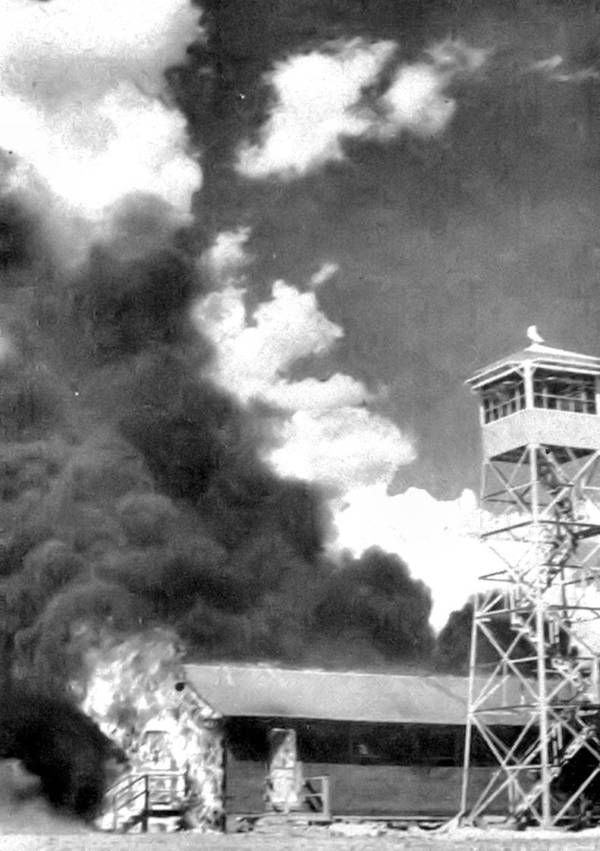The bat bomb was designed to terrorize the people of Japan in a most unexpected way.
By Katie Serena –

Errant bats from the experimental bat bomb set the Carlsbad Army Airfield Auxiliary Air Base in New Mexico on fire on May 15, 1943, when armed bats were accidentally released. The bats roosted under a fuel tank and incinerated the test range. Wikimedia Commons
When one thinks of military strategy, they think of terms like guerrilla warfare or snipers. You know, weapons that cause maximum damage and mass destruction.
They don’t usually assume bats.
However, it may shock you to know that that’s exactly what the White House signed off on in World War II.
The ridiculous plan, in which bombs full of bats, which in turn were carrying smaller bombs, were to be dropped on Japanese cities, was invented by a dentist. Naturally, because who else could come up with something so nightmarish?
Dr. Lytle S. Adams, like most Americans at the time, was enraged by the attack on Pearl Harbor and had begun looking into what he could do to lend his support to the war efforts.
Having just returned from a vacation in New Mexico, he remembered being “tremendously impressed” by the Mexican Free-Tailed Bats, which migrated every year through the state and lived primarily in Carlsbad Caverns.
After reading up on them, he returned to the caverns to capture some for himself (those were different times). Upon studying them, Dr. Adams decided that they were perfectly suited for war.
After all, they were able to withstand high altitudes, fly long distances, and carry heavy loads — such as tiny timed bombs.
Like most Americans in the 30’s and 40’s, Adams image of Japan was a bit skewed. Most people believed Japan was an island of crowded cities “filled with paper-and-wood houses and factories.”.
With that train of thought, he believed that with enough bat bombs, the military could wipe out entire cities simply by letting the bats do what they do best — migrate and hide in dark places.
So he did what any concerned citizen with a brilliant plan would do. He outlined his plan and sent it to the White House.
The proposal seemed like the plot of a B-horror movie. It promised to “frighten, demoralize and excite the prejudices of the Japanese Empire,” claiming that “the millions of bats that have for ages inhabited our belfries, tunnels and caverns were placed there by God to await this hour.”
Adams was clearly paranoid, noting that the plan “might easily be used against us if the secret is not carefully guarded.” However, Adams was also very confident.
“As fantastic as you may regard the idea,” he said. “I am convinced that it will work.”

President Franklin Delano Roosevelt signs a resolution declaring war on Japan after the attack on Pearl Harbor – Bettman/Getty Images
The proposal actually made it into to President Roosevelt’s hands (most likely due to Adams personal friendship with first lady Eleanor Roosevelt), and he passed it along to his head of wartime intelligence Colonel William J. “Wild Bill” Donovan of the OSS (Office of Strategic Services).
Roosevelt also included a letter of his own, backing up Adams preposterous theory. “This man is not a nut,” he wrote. “It sounds like a perfectly wild idea, but is worth looking into.”
The proposal also found its way to Donald Griffin, who had pioneered research on bats’ echolocation strategies. Griffin lent his support to the plan in a letter.
“This proposal seems bizarre and visionary at first glance,” he wrote, “but extensive experience with experimental biology convinces the writer that if executed competently it would have every chance of success.”
After seeing Adams’ demonstration using the bats he had captured himself, the White House assembled a team and eventually agreed upon using the Mexican Free-Tailed bat. The U.S. government then gave the authority for investigations to begin, and the plan eventually became known as Project X-Ray.
Thousands of bats were captured across the southwest, tiny bombs were designed, and a transport method was engineered. However, a hitch in the plan was soon discovered, and after a minor setback where the Carlsbad Army Airfield Auxiliary Air Base caught fire, the plan was scrapped.
It turned out that the transportation of the bats and the cost of researching new methods was the real problem. After 30 different demonstrations and $2 million spent on studies, they gave up. There were, after all, rumors of a far more powerful weapon that could be used — the atomic bomb.
Alas, the bat bomb was not meant to be, however gung-ho the entire White House seemed to be about it. Adams was disappointed. However, he would come up with a few more crazy schemes. Some of which included seed packet bombs and a fried chicken vending machine.
[The infamous “Invasion by Bats” project was afterwards referred to by Stanley P. Lovell, director of research and development for the Office of Strategic Services (OSS), whom General Donovan ordered to review the idea, as “Die Fledermaus Farce”. Lovell also mentioned that bats during testing were dropping to the ground like stones. – Wikipedia]
Though Adams was let down by the bat bomb’s lack of success, we can assume that the bats were pretty happy about it.
(Principal source of this article: https://allthatsinteresting.com/w








